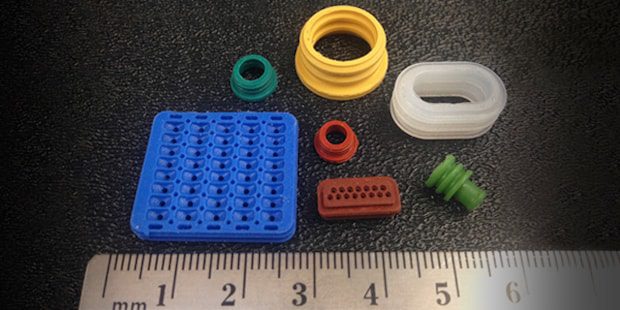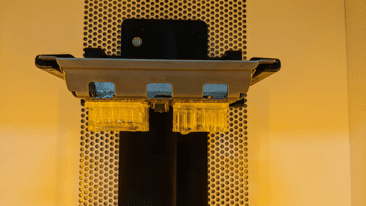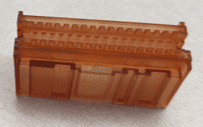3D Printing Offers Design Flexibility and Manufacturing Possibilities
3D printing technology is reaching new levels of quality, giving electronics engineers a powerful prototyping and design tool. But is 3D printing ready for component manufacturing?

Can you 3D print a connector? Certainly. But is it any good—can you actually use it in a circuit? Increasingly, the answer is yes. Recent improvements in industrial grade 3D printers, resins, and other extrudable materials, and the integration of AI in modeling processes have made additive manufacturing—commonly known as 3D printing—a viable manufacturing option for some interconnects and other electronic components.
“You turn around for a year, and new technologies comes along. There are new machines, the resolution is improving, the capabilities are improving, more materials can be printed now, including metal, silicon, different resins, and the quality of the parts is reaching a high level,” said Ralf Klädtke, CTO, Transportation Solutions, TE Connectivity. “When you held a 3D-printed part in your hand a couple of years ago, you could tell immediately it was a 3D printed part, because of the roughness of the surface. It needed some polishing, a lot of afterwork, to get to a similar level as an injection molded part. Now 3D printing has reached such quality that it’s impossible to tell which part was 3D printed and which was injection molded—and some people think the 3D printed part is better.”
For most mass production applications, though, 3D printing is not yet the preferred solution. From industrial point of view, you have to consider criteria like technical feasibility, time-to-market and very important financial feasibility when you want to decide if you go forward with 3D printing. 3D printing is meanwhile technically feasible but not always financially attractive especially for mass production. Right now, the process is widely used for prototyping, custom connectors, and small size, small batch components used in industrial applications.
Rapid prototyping
For now, 3D printing is intensely used in the development process. TE’s Asia Pacific division uses 3D printing for rapid prototyping, said Klädtke. “From customer request to having the prototype part in their hand takes about a week. The customer can fit it, check it, say, ‘Yes, this seems to be what I want,’ and go on to the next steps.” 3D printing has the main advantage of “speed” for prototyping. You do not have to wait for months until an injection molding tool is ready. The next steps typically in Automotive mass production involve traditional methods because 3D printing is not financially viable to produce large numbers. With additive manufacturing, you’ve got to do the setup, the machine then prints a set of parts, then support structures must be removed, surfaces might have to be polished, and then you can use the part. Versus injection molding: There’s a cure time, usually not that long, and it’s usually done by the time it gets to the end of the conveyor line, and then it’s immediately usable. Plus, hundreds or thousands of injection molded components can be turned out in in an hour; more than 5 million metric tons of plastic parts are made every year using injection molding. Meanwhile, 3D printing takes several minutes to several hours, depending on the complexity of the part.
But for small batches, small production runs, or when the “time to market” has to be very fast, 3D printing is increasingly a viable option.
Material issues
Aside from mass production, the key limitation for 3D printed parts was material issues. In the past the variety of available resins and polymers lacked the strength and durability to make them usable for long term and safety-critical applications or was even too expensive. Meanwhile many new materials become available meeting the technical and financial requirements. Connector suppliers are investing in new materials research and experimenting with new chemistries that will deliver a more durable and financially competitive product. “There are even some metals used in 3D printing that are coming out, and they are better and better,” said Klädtke. TE’s labs in Pennsylvania, South Carolina, California, Europe and China are working on materials research, as well as scouting universities and startups. “Who has a new idea? There are so many fresh ideas coming in, and it’s not limited to plastics.”

3D printing can be used in high-value polymers such as glass fiber LCP.
Generative AI aids additive manufacturing
The latest idea to impact additive manufacturing is the integration of AI. “We are using generative design to impact the connector world. When combining Generative AI with 3D printing we can significantly shorten development time and achieve highly competitive time-to-market.,” said Klädtke. “Generative AI works best for variations of products you already have developed in the past. Generative AI can support engineers in dramatically reducing the time to generate all the verification and documents needed to qualify a new product. And adding 3D printing speeds up the time-to-market in addition, as you do not have to wait for injection molding tools to be ready and can start 3D printing right away.” AI modeling can test new design variations, suggest new features, identify potential problems, and calculate new geometries that maximize the part’s success in an application, as well as it’s manufacturability.

An automotive connector, as it comes from the printer.

The same connector, fully cured.
3D printing and sustainability
Remember those millions of tons of injection molded plastic things? All those plastic things, including components, packaging, toys, bottle tops, medical products, and more, quickly become trash, and all that plastic trash is reaching a critical mass in our environment, impacting all life on Earth. New materials for additive manufacturing include bio-based resins and powders. There are closed 3D printing systems that can essentially vacuum themselves clean and put excess resin material back into the system for reuse. In injection molding, , once you’ve melted the plastic pellets down and inject them into the mold, you can’t just grind that up and reuse it; you have to mix it with virgin resin. Usually you are limited to 10% or 20% that can be mechanically recycled. There are certain sustainability aspects of 3D printing that are worth noting.
TE and other companies will continue to refine the role that 3D printing will play in components manufacturing. “At TE already today 3D printing has moved from the laboratory for prototypes to the production shopfloor for serial component production. Meanwhile real industrial serial production is feasible and is growing for selected industries and applications.. In the future, with improving 3D printing technologies, more advanced resins and metals for 3D printing and cost reductions enabling financial viability, 3D printing will become more dominant on the production shopfloor”. “Things are moving fast in 3D printing. The combination of AI and 3D printing is a very powerful one that will get a lot of attention in the next years to come.” said Klädtke. “AI is likely to unleash the potential of 3D printing further, enabling dramatically reduced development times and time-to-market.”
Learn more about 3D printing for production at TE Connectivity.
Like this article? Check out our other Manufacturing and Materials articles, our Connector & Cable Special Topics Market Page, and our 2023 and 2024 Article Archives.
Subscribe to our weekly e-newsletters, follow us on LinkedIn, Twitter, and Facebook, and check out our eBook archives for more applicable, expert-informed connectivity content.
- Where in the World is Amphenol LTW’s Luc Kan? - April 23, 2024
- TE Connectivity’s Sustainability Efforts Pay Off - April 23, 2024
- What is a VGA Connector? - April 23, 2024


